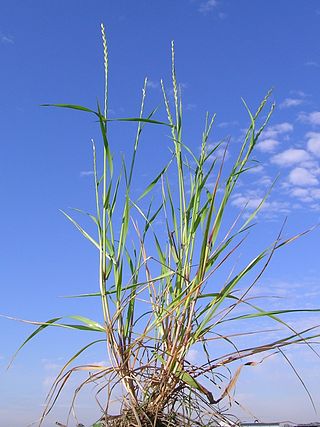
Panicum miliaceum is a grain crop with many common names, including proso millet, broomcorn millet, common millet, hog millet, Kashfi millet, red millet, and white millet. Archaeobotanical evidence suggests millet was first domesticated about 10,000 BP in Northern China. The crop is extensively cultivated in China, India, Nepal, Russia, Ukraine, Belarus, the Middle East, Turkey, Romania, and the United States, where about 500,000 acres are grown each year. The crop is notable both for its extremely short lifecycle, with some varieties producing grain only 60 days after planting, and its low water requirements, producing grain more efficiently per unit of moisture than any other grain species tested. The name "proso millet" comes from the pan-Slavic general and generic name for millet. Proso millet is a relative of foxtail millet, pearl millet, maize, and sorghum within the grass subfamily Panicoideae. While all of these crops use C4 photosynthesis, the others all employ the NADP-ME as their primary carbon shuttle pathway, while the primary C4 carbon shuttle in proso millet is the NAD-ME pathway.

Eleusine coracana, or finger millet, also known as ragi in India, kodo in Nepal, and kurakkan in Sri Lanka, is an annual herbaceous plant widely grown as a cereal crop in the arid and semiarid areas in Africa and Asia. It is a tetraploid and self-pollinating species probably evolved from its wild relative Eleusine africana.

The oat, sometimes called the common oat, is a species of cereal grain grown for its seed, which is known by the same name. While oats are suitable for human consumption as oatmeal and rolled oats, one of the most common uses is as livestock feed. Oats are a nutrient-rich food associated with lower blood cholesterol when consumed regularly.

Arrhenatherum, commonly called oatgrass or button-grass, is a genus of Eurasian and North African plants in the grass family.

Chenopodium album is a fast-growing weedy annual plant in the genus Chenopodium. Though cultivated in some regions, the plant is elsewhere considered a weed. Common names include lamb's quarters, melde, goosefoot, wild spinach and fat-hen, though the latter two are also applied to other species of the genus Chenopodium, for which reason it is often distinguished as white goosefoot. Chenopodium album is extensively cultivated and consumed in Northern India, and Nepal as a food crop known as bathua.

Lolium is a genus of tufted grasses in the bluegrass subfamily (Pooideae). It is often called ryegrass, but this term is sometimes used to refer to grasses in other genera.

Pennisetum is a widespread genus of plants in the grass family, native to tropical and warm temperate regions of the world. They are known commonly as fountaingrasses. Pennisetum is considered a synonym of Cenchrus in Kew's Plants of the World Online.

Avena sterilis is a species of grass weed whose seeds are edible. Many common names of this plant refer to the movement of its panicle in the wind.

In plant biology, Vavilovian mimicry is a form of mimicry in plants where a weed evolves to share one or more characteristics with a domesticated plant through generations of artificial selection. It is named after Nikolai Vavilov, a prominent Russian plant geneticist. Selection against the weed may occur by killing a young or adult weed, separating its seeds from those of the crop (winnowing), or both. This has been done manually since Neolithic times, and in more recent years by agricultural machinery.
Wild Oats or wild oat may refer to:

Avena fatua is a species of grass in the oat genus. It is known as the common wild oat. This oat is native to Eurasia but it has been introduced to most of the other temperate regions of the world. It is naturalized in some areas and considered a noxious weed in others.

Avena strigosa is a species of grass native to Europe. It has edible seeds and is often cultivated as animal feed in southern Brazil. It is sometimes reported as a weed.

Avena nuda is a species of grass with edible seeds in the oat genus Avena.

Avena brevis, the short oat, is a species of grass in the family Poaceae whose seeds are edible.

Bromus hordeaceus, the soft brome, is an annual or biennial species of grass in the grass family (Poaceae). It is also known in North America as bull grass, soft cheat, and soft chess.
Avena abyssinica, also known as the Ethiopian oat and "Ajja" by Ethiopians, is a member of the family Poaceae. This grain has long been used in Ethiopia and is well adapted to the high elevations and other conditions there. Still a traditional food plant in Africa, this little-known grain has potential to improve nutrition, boost food security, foster rural development and support sustainable landcare.

Eragrostis pilosa is a species of grass in the family Poaceae. It is native to Eurasia and Africa. It may or may not be native to North America. It is widely introduced, and it is a common weed in many areas.

Lolium rigidum is a species of annual grass. Common names by which it is known include annual ryegrass, a name also given to Italian ryegrass, rigid ryegrass, stiff darnel, Swiss ryegrass and Wimmera ryegrass. It is a native of southern Europe, northern Africa, the Middle East and the Indian subcontinent and is grown as a forage crop, particularly in Australia, where it is also a serious and economically damaging crop weed.

Butafenacil is the ISO common name for an organic compound of the pyrimidinedione chemical class used as an herbicide. It acts by inhibiting the enzyme protoporphyrinogen oxidase to control broadleaf and some grass weeds in crops including cereals and canola.
Brachiaria deflexa is a annual millet grass belonging to the grass family (Poaceae). It is native to many regions such as Africa, India, and Pakistan in both tropical and subtropical regions. It has been used as a supplemental food source among other cereal crops.

















